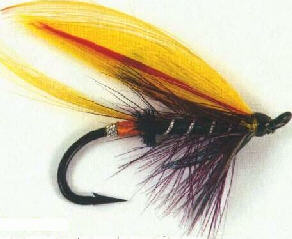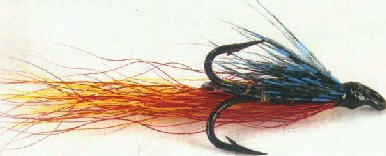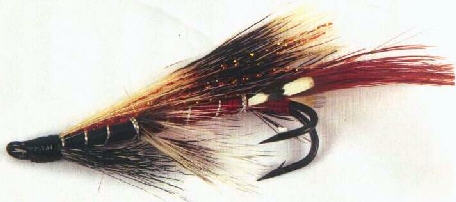Irish Angler Article
published 16 April 2004, launch issue.
Slaney Silver
The River Sidney is arguably Ireland's best east coast salmon river. Here we reveal the top stretches and the tackle you'll need to catch a Slaney springer.

Best East Coast River
Springtime heralds the start of the salmon fishing season. However, catching a spring salmon these days isn't quite as easy as it used to be. Springers, as they are known, are becoming more and more scarce.
When we speak of springtime salmon fishing, seldom are the rivers of the east coast mentioned. Although spring runs have declined to a trickle on many of the once-famous cast coast rivers such as the Dee and Boyne, the River Slaney stands alone as the one remaining fishery that is still worth a visit in the months of March, April and May. The average weight of the salmon on the Slaney has increased in recent years and has now hit l0 lb, with springers varying in size from 7lb to 20lb.
The Slaney rises on the western slopes of Lugnaquilla Mountain and flows in a southeasterly direction through Baltinglass, Tullow and Bunclody, before entering the estuary at Enniscorthy.
It is a wide river with a strong flow that is punctuated with slow-flowing areas and pools. The river between Enniscorthy and Bunclody is excellent springer territory, being wide and fast flowing. It contains a number of good salmon lies. From Bunelody to Tullow the banks are generally clear and the river is wide, with a strong, fast current. However, there are a good number of weirs separated by pools and some slower-flowing areas, all of which hold salmon. The stretch from Tullow to Ballinglass is fast flowing, rocky and, in parts, overgrown.
Ballintemple
I've had the good fortune to fish the Slaney on a number of occasions, and I have had a number of memorable days on the Ballintemple and Kilcarry beats (which arc localed downstream of Tullow).
Famous author and angler Kingsmill Moore once owned the famous 'Mill Pool' and the adjoining two heats below Ballintemple. There is a palpable sense of history that permeates this place and one cannot help but conternpl;ite the many extraordinary events and battles that have taken place there, including the Battle Of Vinegar Hill -a famous confrontation that took place alongside this historic river.
The Ballintemple beats consist of approximately 2 ½ miles of
water, starting at Payne's Weir on the upstream side and finishing on
the downstream side below the Larch Stream at the Kettle Pipe. Extensive
development work. to improve flows and lies, was carried out on this stretch
of river in the early 1990s and within the last six years Robin Eustace
Harvey has commissioned extensive repairs to many of the weirs damaged
by the powerful flood waters of the Slaney.
The upper beats at Ballintemple consist of the Hazels and Powers heats,
which are divided by 'Four Black Rocks', a famous holding area. The middle
section consists of the Gatcheen and Escurra beats and includes the productive
lies at the Sally Well, Sheepwash and Ladies Pool, so called because it
was used and reserved as a swimming pool for the ladies of the big house
(Ballintemple House).
The Rhododendron Walk bursts into colour in April and is one of the most attractive areas on the river. The lower beats comprise the Larch Stream and Fox's Well and include the hotspot at the Half Moon Pool and weir.
Tackle Requirements
Anyone planning to visit the Slaney should carefully consider their tackle requirements. Your choice of rod, reel, line and flies will be dictated by the prevailing water and weather conditions. Any visit to the Slaney should include a choice of at least three rods.
Firstly, there is what I would consider the heavy artillery. Tackle should consist of a 15ft 11-wt double-handed rod. This is the sort of tackle that is required for springtime fishing when the water is pulling through at a rate of knots. In such conditions your reel should be filled with a sink-tip line complete with adequate backing and a fast-sinking braided leader. The leader needs to be attached loop-to-loop to the fly line. This tackle allows for enhanced presentation as it affords the angler better control over the line and fly, a fact that will greatly increase the chances of success.
A selection of flies should include traditional salmon patterns in sizes 8 to 10, as well as tubes and Waddington-style flies. In particular you should include the Willie Gunn, Gold Willie Gunn and Yellow Shrimp in your fly box.
Spring Temperature
At this time of year, water temperature and clarity all play a critical role in how salmon react. The fly needs to get down to where the fish are lying. Fishing higher in the water will lead to a blank day whereas finding the correct depth will increase the chances of taking a fish.
In heavy water at Ballintemple the salmon lie back from the weirs and fast water. They search out the lies in centre and tails of the glides, where they need to less energy holding their station.
The Four Black Rocks is one such holding area and fish regularly lie in the deep, steady flow between and behind these rocks. Fish betray their presence by showing regularly in this area and the conventional style of fishing across and down ensures that each lie is covered and should bring results. It would not be unusual for six to eight fish to lie in the area from the rocks to the pulpit.
As water levels drop, anglers can be faced with medium to low flow rates and tackle requirements must change to accommodate the new conditions. Recommended tackle for these friendlier conditions consists of a single-handed 9ft 6in rod, rated for a 8-wt line.
A choice of two lines is advisable, including an intermediate line and a floating line with a sinking tip. Fly sizes can also be scaled down as the water levels drop.
It is worth noting the changes in approach we will need to adopt with the drop in levels and increase in water temperature. Fish will be lying higher in the water to such an extent that it is possible to fish too deep when the water level has dropped. Fish can change their location with falling water levels and, in low water, fishing at Ballintemple can be confined to the riffle areas around the weirs.
The third set of tackle should consist of an 8ft 6in to 9ft trout rod for a 5-wt floating line. Why? Plain and simple, there are some days when its just not going to work out and after travelling any kind of distance you are better off enjoying a day's brown trout or sea trout fishing than going home frustrated and annoyed.
The trout gear can also be used in the lull between the best salmon fishing periods, namely dawn until 11 am and 4pm until dusk. However, I have leamt from Ballintemple guide Tony Sweeney that these times are not definitive.
Sea Trout
Tony has fished the Slaney for over 20 years and knows this and other stretches of the river intimately. Arriving to fish at 11am, Tony has been greeted regularly by calls of: "You may as well go home, you're too late!"
On more than one occasion he has confounded these callers by taking fish when and where the others had failed. He explains that he believes that the shadows cast by the trees on the Ballintemple side and the correct choice of tackle were mainly responsible for his success. Tony places great emphasis on water temperature and alters his fishing depth as the temperature changes.
As spring changes to summer, the fish keep coming but in smaller numbers and smaller sizes. The Slaney does get a nice run of sea trout. Granted they are not very big, but they can provide excellent sport. In July of last year Tony had visitors from America on the fishery at Ballintemple. They tried for salmon for a few hours but, despite having seen several fish, nothing was landed.
Tony advised fishing for sea trout instead. On walking the river. Tony had observed several fresh sea trout rising in the riffle area at the Sally Well Stream and he invited a young visitor to try his luck. On the second cast a silver flash tore across the surface, seized the fly and then all hell broke loose. The rod tip dipped into the water and a grilse of approximately 51b bounced like a pinball across the pool before breaking free. Despite the loss, the anglers enjoyed a memorable day's fishing at Ballintemple. When I think about the distance that some people have to travel to enjoy a day's fishing, it makes me appreciate all the more what we have on our doorstep.
| Willie Gunn Waddington Hook: Tied on a Waddington, with a shank length of l^/i inches, IV; inches, P/4 inches or occasionally 2 inches with size 6 trebles. Rib: Oval gold tinsel. Body: Black floss. Wing: Yellow buck tail, under orange buck tail, under black buck tail. Irish Angler comment: The Willie Gunn can also be tied on single, double and treble hooks or tubes. |
 |
 |
Black Goldfinch Hook: Single or double can be used in sizes 10 to 4/0. Tag: Fine round silver tinsel and orange floss. Tail: Golden pheasant topping and Indian crow substitute. Butt: Black ostrich. Rib: Oval silver tinsel. Body: Black floss. Hackle: Claret cock from second turn of the rib. Throat: Blue jay. Wing: Married slips of yellow and red swan with a topping over. Irish Angler comment: This is a popular fly on the River Slaney in the spring, with 2/0 and 3/0 hooks being favoured. |
|
Garry Dog |
 |
 |
Slaney Badger |
| Yellow Shrimp Hook: This pattern can be tied either on a single, double or treble hook in sizes 6 to 12. Tag: Oval silver tinsel. Tail: Golden pheasant red breast feather. Rear body: Yellow seal's fur or floss. Rib: Oval silver tinsel. Middle hackle: Rich yellow cock hackle. Front body: Black seal's fur or floss. Front hackle: Badger. Eyes: Small jungle cock. Head: Black varnish. Irish Angler comment: This is a fly that works well in coloured water and if the weather is bright. |
| Methods: |
Bag limit: |